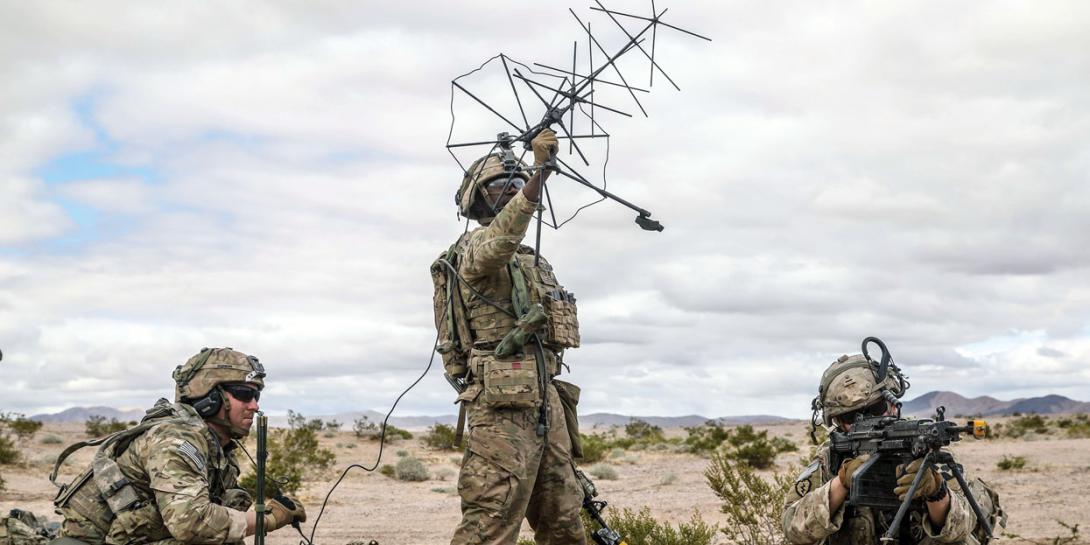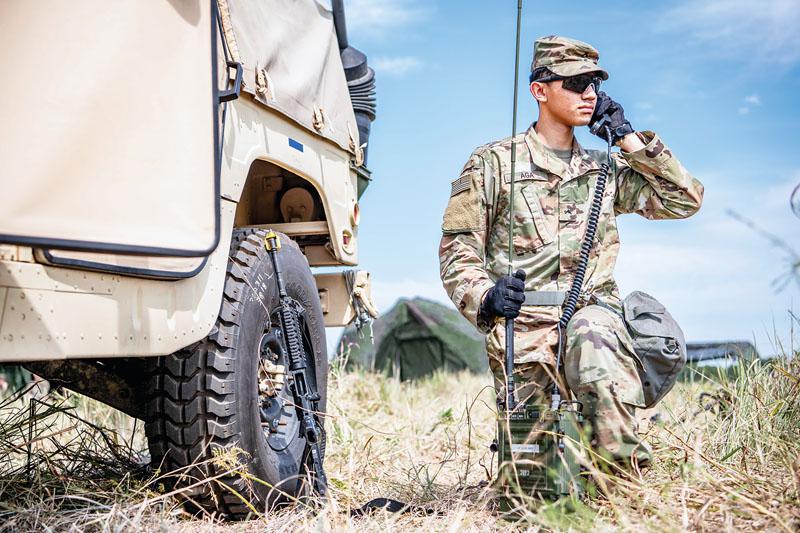Army Mulls Expeditionary Experiments
When the U.S. Army conducts its Multi-Domain Operations Live experiment in the Indo-Pacific region next year, it will mark the first time the service has undertaken a full-scale technology development experiment in a combat theater. The goal is to assess technologies under the same conditions they will face in times of war, rather than in a stateside setting.
Multi-Domain Operations (MDO) Live, which will be held this summer, is the new name for the experiment formerly known as Cyber Blitz. The service held its final Cyber Blitz earlier this year. “The name Cyber Blitz pigeonholed us into this thinking it’s all about cyber. If you’re familiar with Cyber Blitz 19, really, it had grown into a multidomain operations experiment. We thought it best to change the name because it better reflects what we’re doing and providing from an experimentation venue,” says Randy Wheeler, associate director for field-based experimentation within the Army Futures Command’s Command, Control, Communications, Cyber, Intelligence, Surveillance and Reconnaissance (C5ISR) Center.
Service officials are in the early planning stages for MDO Live 21, but so far they expect it to be held during the July and August timeframe. For the first time, it will take place in an operational theater and will be tied to an operational exercise, Defender Pacific. “MDO Live 21 next year will be forward in theater, in the Indo-PACOM [Pacific Command] theater,” Wheeler reports. “MDO Live will pick up the experimentation capability and move it to the PACOM area of responsibility.”
Like Cyber Blitz in the past, MDO Live 21 will provide the Multi-Domain Task Force, which includes an element known as the Intelligence, Information, Cyber, Electronic Warfare and Space unit, or I2CEWS, with an opportunity to train nonkinetic capabilities. Indo-Pacific is currently the U.S. military’s highest-priority theater, where near-peer adversaries China and Russia have significant influence. There are plans to establish a similar Multi-Domain Task Force in Europe next year and to stand up a third one in 2022 that would also operate in the Indo-Pacific region, according to a Defense Department article.
The nonkinetic domain didn’t get a lot of emphasis prior to Cyber Blitz, which started in 2016. “It was on the too-hard-to-do side of the house,” Wheeler says. “Cyber Blitz has brought that nonkinetic environment to life to allow soldiers to get their hands on emerging science and technology and capabilities and train as a unit in the live environment.”
The Army will use the MDO Live 21 experiment, which Wheeler describes as “Cyber Blitz on steroids,” and the Defender Pacific exercise to continue to refine the doctrine, force design, concept of operations and employment, and tactics, techniques and procedures for I2CEWS units and will likely use a larger version of the unit than in previous experiments and exercises. “As far as a force design, it’s probably bigger than the current unit at Joint Base Lewis-McChord that was essentially built for an experimentation capability. It wasn’t the full design,” Wheeler reports. “It was meant to inform what the full design should be. We anticipate experimenting with something closer to a full design, and that’s going to require more soldiers.”
An in-theater experiment provides a more relevant environment for assessing cutting-edge technologies. “We are preparing ourselves to have an expeditionary experimentation capability to support operational units that want to do those kinds of things in operationally relevant environments,” Wheeler says.
Previous Cyber Blitz experiments were held primarily at Joint Base McGuire-Dix-Lakehurst, New Jersey, which was formed by combining the Army’s Fort Dix with McGuire Air Force Base and Naval Air Engineering Station Lakehurst. “It’s one thing to bring soldiers into that environment and train at Fort Dix. It’s another thing to train in the environment that they anticipate operating in. We understand there are differences, and we can replicate certain things, and we can surrogate environments, if you will, but there’s nothing like experimenting in the real world if you’re doing field-based experiments in the no-kidding relevant environments,” Wheeler says.
Although the service has done some “distributed experimentation,” it has not conducted a full-fledged experiment in theater. “We’re preparing ourselves to make sure we can take our infrastructure and all of our experimentation capability and be prepared in the future to pick that up and take it to a unit, perhaps, in a relevant environment and conduct that experiment there,” Wheeler offers. “We have some capability to do that, and we have a capability to do some distributed experimentation as well, but I’m not aware of a time that we’ve taken a major event like a Cyber Blitz or an MDO Live 21 and essentially picked it up and moved it into an operational theater. We haven’t done that to the degree we’re thinking it might be requested in the future.”
The move into theater will present challenges, he explains. “If you’re trying to tie into operational networks with experimental capabilities, you have authority-to-operate issues. We have some of those capabilities in the lab, and we can do those in closed environments, but trying to do that perhaps tied into an operational network in an operational exercise has some challenges. We have to work through those.”
Logistics presents another challenge for expeditionary experimentation. “Just the logistics of having to pick up all of the fly-away kits and that kind of thing and having to set up perhaps in a distributed environment in theater obviously has challenges. From an experimentation perspective, keeping everything communicating forward in theater has its own challenges,” Wheeler adds.
But it’s too early to tell whether expeditionary experimentation will be the wave of the future. “We are thinking ahead that that could be something we support, but whether that’s on an annual basis, I’m not sure yet,” Wheeler states. “We’ll certainly always have experimentation at Fort Dix and Lake Hurst. That will continue. MDO Lives in the future may even be there. We’re just preparing ourselves to make sure that we’re a little more expeditionary in our capability to pick up our experiments and move them as needed.”
MDO Live 21 will focus on technologies of interest to the Indo-Pacific region. Some of those areas of interest—sensor communication architectures, sensor fusion and translation software, cross-domain solutions, identity management and an MDO common operating picture—were in a request for information released earlier this year.
MDO might also include some technologies that performed well in the Network Modernization Experiment (NetModX). The NetModX experiment includes roughly 20 systems focused primarily on command post survivability and mission command resiliency. Key experiments include technologies for hardened waveforms in support of protected communications, protected satellite communications, defensive cyber, command post survivability and protected communications for the teaming of manned and unmanned vehicles.
The purpose of the request for information is to give industry a chance to showcase solutions that might be included in the exercise. Additional requests for information tied to MDO Live 21 may be forthcoming. “We’ve set up tiger teams within the center to look at different opportunity areas we know we need to focus on for MDO Live. We’re encouraging those tiger teams that if they need to push out another [request for information] for a specific area that they do so. We expect that to happen over the next couple of months,” Wheeler offers.
MDO Live 21 also will more heavily emphasize joint operations than past Cyber Blitz experiments. “It is more than just cyber. It’s more than just CEMA. It’s definitely pulling in the joint force and joint capabilities and how we integrate those,” Wheeler says. “All of the joint forces are represented, including the new Space Force, as far as our early planning for MDO 21.”
Next year’s experiment also will likely include more soldiers than usual. “You know Cyber Blitz is our center’s preeminent soldier touchpoint for science and technology. That will continue. In the past, you might have seen upwards of 100 soldiers, 150. What we’re envisioning for MDO Live 21 next year is to double or triple that number of soldiers involved,” Wheeler says.
“This year’s Cyber Blitz was somewhat limited in preparation for MDO Live 21. U.S. Army Pacific really wanted to focus Cyber Blitz on this technology characterization for some technologies that they’re interested in, so we’re executing that. It’s very scaled down, basically no soldiers involved. They really wanted us to focus on this bigger event, MDO Live 21, in support of their exercise, under the Defender Pacific umbrella next year,” Wheeler explained.







Comments